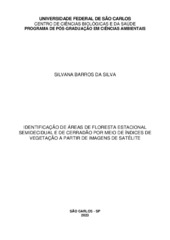| dc.contributor.author | Silva, Silvana Barros da | |
| dc.date.accessioned | 2023-05-30T19:12:43Z | |
| dc.date.available | 2023-05-30T19:12:43Z | |
| dc.date.issued | 2023-03-30 | |
| dc.identifier.citation | SILVA, Silvana Barros da. Identificação de áreas de floresta estacional semidecidual e de cerradão por meio de índices de vegetação a partir de imagens de satélite. 2023. Dissertação (Mestrado em Ciências Ambientais) – Universidade Federal de São Carlos, São Carlos, 2023. Disponível em: https://repositorio.ufscar.br/handle/ufscar/18091. | * |
| dc.identifier.uri | https://repositorio.ufscar.br/handle/ufscar/18091 | |
| dc.description.abstract | Brazilian forests have suffered vertiginous reductions over the years, leading phytophysiognomies such as the Atlantic Forest and the Cerrado to be considered priority areas for conservation, however, there is a need to monitor and identify these areas for their effective protection, which is not always easy. Although remote sensing studies are widely used to monitor the state of forest remnants, there are still difficulties in identifying the different phytophysiognomies through satellite monitoring, mainly in phytophysiognomies with floristic similarity Thus, the present work sought to analyze phytophysiognomies associated with the Cerrado and the Atlantic Forest, based on Sentinel-2 satellite images, verifying whether the NDVI (Normalized Difference Vegetation Index) and S2REP (Sentinel 2 Red Edge Position) are viable indices to distinguish the phytophysiognomies of Cerradão and Semideciduous Seasonal Forest. This work has been carried in six locations, twelve of which are forest remnants, in the State of São Paulo. The formations are adjacent areas of Cerradão and the Semideciduous Seasonal Forest. Data were analyzed in two distinct seasons, summer and winter. Descriptive analyses and the Analysis of Variance (ANOVA) test were performed. The results indicated that the NDVI and S2REP can identify significant differences between the Cerradão and FES formations, making it possible to determine if nearby areas are of the same phytophysiognomy. Also, the effect of seasonality on the values of the indexes analyzed was identified, with a greater influence of the seasons than the phytophysiognomy. It was concluded that remote sensing is a complementary tool to the floristic and phytosociological survey in the classification of phytophysiognomies. | eng |
| dc.description.sponsorship | Não recebi financiamento | por |
| dc.language.iso | por | por |
| dc.publisher | Universidade Federal de São Carlos | por |
| dc.rights | Attribution-NonCommercial-NoDerivs 3.0 Brazil | * |
| dc.rights.uri | http://creativecommons.org/licenses/by-nc-nd/3.0/br/ | * |
| dc.subject | Sensoriamento remoto | por |
| dc.subject | NDVI | por |
| dc.subject | S2REP | por |
| dc.subject | Savana | por |
| dc.subject | Sentinel 2 | por |
| dc.subject | Remote sensing | eng |
| dc.title | Identificação de áreas de floresta estacional semidecidual e de cerradão por meio de índices de vegetação a partir de imagens de satélite | por |
| dc.title.alternative | Identification of seasonal semidedecidual forest and cerradao forest areas utilizing vegetation indices from satellite images | eng |
| dc.type | Dissertação | por |
| dc.contributor.advisor1 | Sebastiani, Renata | |
| dc.contributor.advisor1Lattes | http://lattes.cnpq.br/9773755519907716 | por |
| dc.contributor.advisor-co1 | Lopes, Luciano Elsinor | |
| dc.contributor.advisor-co1Lattes | http://lattes.cnpq.br/6504793265492545 | por |
| dc.description.resumo | As florestas brasileiras têm sofrido vertiginosas reduções ao longo dos anos, levando as fitofisionomias como Mata Atlântica e o Cerrado serem consideradas áreas prioritárias para conservação, porém há necessidade do monitoramento e identificação dessas áreas para sua efetiva proteção, o que nem sempre é fácil. Apesar dos estudos a partir do sensoriamento remoto serem amplamente utilizados para monitorar o estado dos remanescentes florestais, ainda existem dificuldades para identificar as diferentes fitofisionomias através do monitoramento via satélite, principalmente, em fitofisionomias com similaridade florística. Assim, o presente trabalho buscou analisar fitofisionomias associadas ao Cerrado e à Mata Atlântica, a partir de imagens do satélite Sentinel- 2, verificando se o NDVI (Normalized Difference Vegetation Index) e S2REP (Sentinel 2 Red Edge Position) são índices viáveis para distinguir as fitofisionomias de Cerradão e Floresta Estacional Semidecidual. O Trabalho foi realizado doze remanescentes florestais, de seis localidades do Estado de São Paulo. As formações são áreas adjacentes de Cerradão e Floresta Estacional Semidecidual. Os dados foram analisados em duas estações distintas, verão e inverno. Foram realizadas análises descritivas e o teste de Análise de Variância (ANOVA). Os resultados indicaram que o NDVI e S2REP conseguem identificar diferenças significativas entre as formações de Cerradão e FES, possibilitando determinar se áreas próximas são da mesma fitofisionomia. Também, foi identificado o efeito da sazonalidade nos valores dos índices analisados, com influência maior das estações do que da fitofisionomia. Concluiu-se que sensoriamento remoto é uma ferramenta complementar ao levantamento florístico e fitossociológico na classificação das fitofisionomias | por |
| dc.publisher.initials | UFSCar | por |
| dc.publisher.program | Programa de Pós-Graduação em Ciências Ambientais - PPGCAm | por |
| dc.subject.cnpq | CIENCIAS AGRARIAS::RECURSOS FLORESTAIS E ENGENHARIA FLORESTAL | por |
| dc.subject.cnpq | CIENCIAS EXATAS E DA TERRA::GEOCIENCIAS | por |
| dc.subject.cnpq | CIENCIAS EXATAS E DA TERRA::GEOCIENCIAS::GEOFISICA::SENSORIAMENTO REMOTO | por |
| dc.publisher.address | Câmpus São Carlos | por |
| dc.contributor.authorlattes | http://lattes.cnpq.br/2865245972909378 | por |
| dc.contributor.authororcid | https://orcid.org/0000-0001-9350-0933 | por |
| dc.contributor.advisor1orcid | https://orcid.org/0000-0003-4565-6137 | por |

